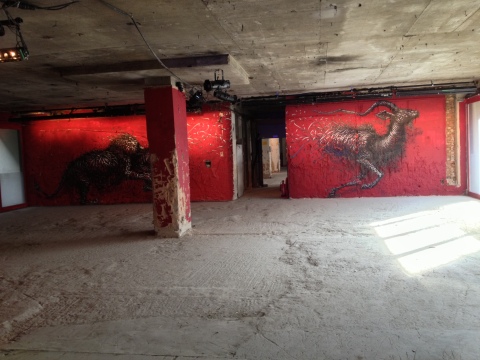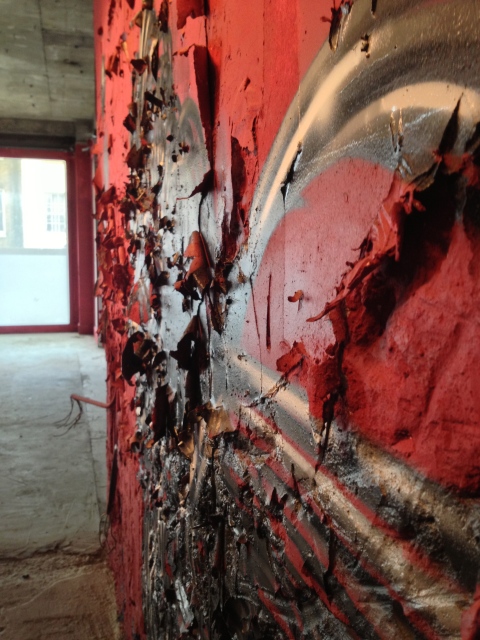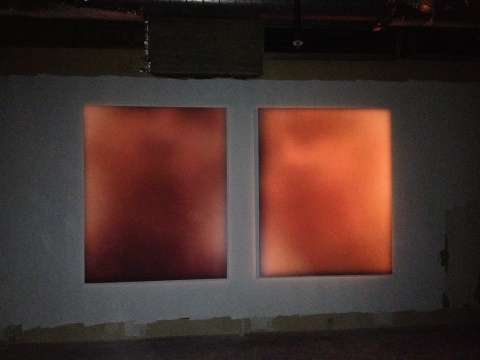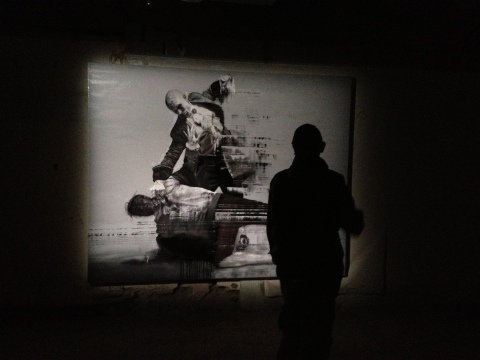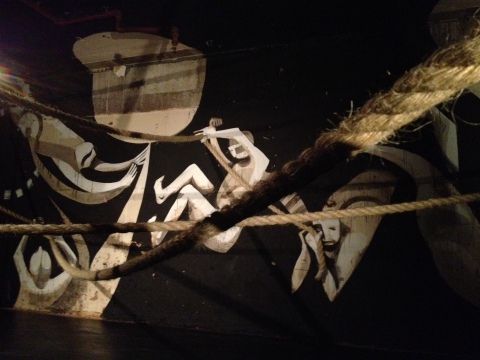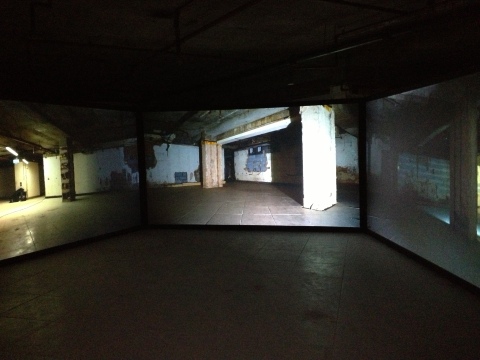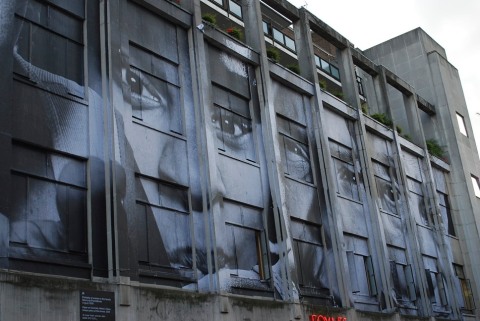Archive for the ‘Lazarides’ Tag
Brutal…..
I’m spending a few hours hanging out where there’s some free wifi and hoping to upload another post before I have to head to the airport.
I had intended to post something further about Berlin (there are actually a few posts I’d like to write) but I decided instead to post some photos from an exhibition I was lucky enough to get to see here in London.
‘Brutal’ is a group show organised by Steve Lazarides and the Vinyl Factory, scheduled to run during London Art Week, as with previous group shows over the last several years. For each of these shows Lazarides selected sites outside of gallery space, sites that enhance the ‘urban’ dimension of the artists or artworks that he includes. This year’s show is no exception to that, located at 18 The Strand, a disused office building. the building is next door to Kings College and on one of London’s busiest thoroughfares, but once inside, the noise and bustle disappear, leaving the visitor in a space filled with shadows, plaster dust and silence.
Most of the exhibition takes place on the basement level, but at ground floor, there is a room filled with and assortment of artworks, including by JR, Faile and Blu, and another large space containing a three part set of murals by Dal East. Here’s a shot of two of the walls:
The paint is applied directly onto walls that are peeling and eroding, which results in an amazing textural quality to the artwork:
After these two rooms, the exhibition moves downstairs and all natural light is left behind. Downstairs, it’s impossible to know what time of day or night it might be outside (that partly explains why, at the opening preview, people stayed in the building for hours with little sense of time passing…). The space is vast, and, after an initial brightly lit area filled with glass sculptures, extremely dark. (It is actually so dark that reading the didactic text about the artworks is well nigh impossible, requiring the torch facility on my smart phone). Here’s a small selection of what is hidden in the shadows:
Two glorious pieces by the Miaz Brothers, hanging on a distant wall within the basement. As you approach, the orange glow increases, until you confront two Rothko-like, floating canvasses. The works are painted on canvas, and shadowy, blurred faces can just be made out within them:
Some of my favourite painters are included. Here’s Conor Harrington’s piece:
And there is an entire room painted by Lucy McLauchlan. Lucy’s work is often intensely decorative; here, the piece retains that sensibility but a harder edge has been added through the installation of rope and the claustrophobic atmosphere of the room through which the figures swing. You can climb under the ropes to view the walls from all angles, and the ropes add new sightlines within the space….
There is a lot of video work in the show. Doug Foster’s massive installation, ‘Moonland’, with its endlessly swirling black and white shapes. Todd James’s ‘Brutal Animation’, which many seemed to love, but which left me pretty indifferent: I wished there had been a better display of the work, and perhaps a more elaboration installation built around the video, allowing James’s paintings to be included as well. And there’s ‘Survivor’ by Karim Zeriahen, a three-screen installation, which packed quite an emotional punch, and which culminated in shots of the room in which it is installed, thus mirroring the space of the artwork with the space in which the spectator is standing:
In addition to these, you could wander into a room filled by Mark Jenkins’s sculptures (and if you were lucky, discover the one hidden in a pile of rubble near the Todd James video piece), you could be tormented by gas mask-wearing performance artists on bicycles, and you could eat miso soup supplied as part of Brad Downey’s installation, ‘Tarpaulin Cafe’. I made two visits to this show, and I still think I didn’t find all of the artworks that may have been hidden away in the shadows. Both times, i spent much longer in the space than I imagined I would. Both times I found artworks of great beauty and skill (along with some that left me less enthused). I haven’t been to any of the previous group shows, so I leave it to others to debate whether this one is ‘better’ or ‘worse’. Whatever, it’s an undoubtedly fascinating experience.
You have been invaded….
To coincide with the about-to-open show at Lazarides’ Rathbone Place gallery in London, I thought it was a good time to post this little homage to the wonderful Invader.
For those of you who don’t know Invader’s work, Invader is a French artist who makes and remakes small mosaics of the ‘Space Invader’, star of countless video games in the 1970s.
I always think of Invader’s works as occupying space in the street very quietly: due to their smallness, they tend to be unassuming and easy to miss, often placed high up on a street corner, or in some hard-to-reach location. (I’ve written recently about the appeal of the small – have a look here).
Once you do notice them, they have great appeal: as mosaics, they have an artisanal quality that provides a nice contrast with the low-culture evoked by the video game referent.
On his website, Invader repeats the trope of ‘invasion’ in another way, so that cities become sites to be invaded by the artist and his mosaic tiles. It’s obviously a militaristic metaphor, and one which is often used by the opponents of graffiti, who see illicit imagery as something which ‘invades’ a previously ‘clean’ wall. It’s one of the great things about Invader’s artwork that it can pinpoint the hysteria that underlies anti-graffiti rhetoric, for here, indeed, are the fearful ‘invaders’, and it has to be asked, who could fail to love these little mosaics?
In addition to his dedicated work in invading (to date) 40 cities around the world, in recent years, Invader has also had a number of gallery shows. I’m unsure how successful his work is in the gallery setting, but it certainly draws a lot of strength from fine art movements such as Pop Art. For me, Invader is at his best in the street, and so, while I recommend that anyone who is in London over the next month takes a look at his gallery show, I wanted to pay tribute to the enduring charm of the Space Invaders that can be found all around us – in the streets. I believe that Invader has been busy adding some new works to the streets of London in the last little while, so keep your eyes open for those. But for now, here are some of my favourites.
In Amsterdam:
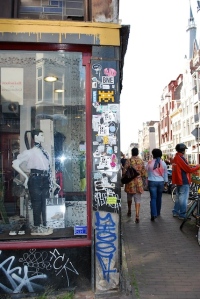
In Shoreditch, London:
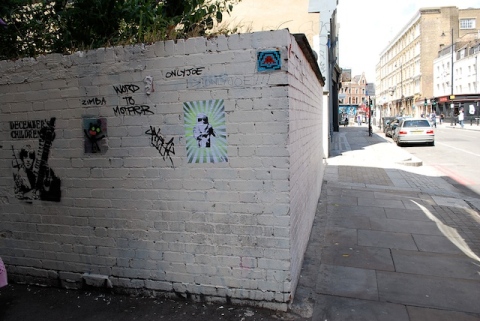
Not far from the Tate Modern, in London:

In Rothsay Place, in Melbourne’s CBD:
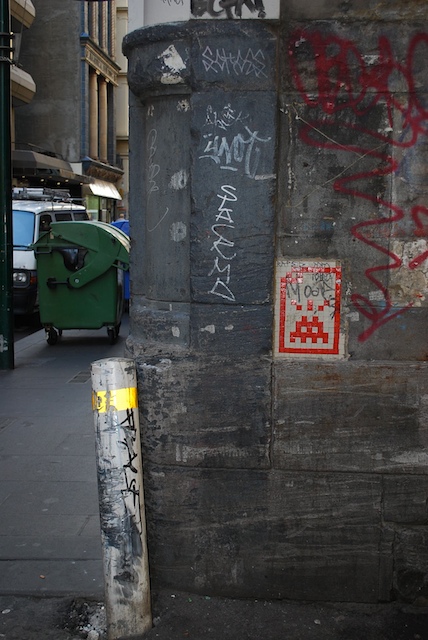
Just off Alexandra Parade, in Melbourne, a very faded example:

In SoHo, New York City:

Enjoy the show, if you get to see it at Lazarides. But, even better, enjoy the streets if you are lucky enough to have been invaded!
‘The power of vision’: JR and the women
JR is a French photographer who used to paste up in the street the poster-sized printouts he had made of his photographs. Since he did this without the permission of the property owner on whose building he would stick the artwork, his art was, of course, illegal. JR has become one of the most internationally celebrated ‘street’ artists (have a look at his website to get a sense of his fantastic work). He is one of the six artists who were selected to exhibit their work on the front of the Tate Modern in London earlier this year (see the blog entry in October, ‘Street art and the museum’).
He has built this huge international reputation around a simple but clever artistic device. He makes portrait photos: head-and-shoulders shots, waist-upwards shots, extreme close-ups of faces or of facial features such as eyes. These photographs are then blown up. It’s through this simple device that JR has become famous – the photograph replicated and expanded in size, pasted up around the streets. These portraits were also made within the parameters of a political point of view. JR’s artworks draw the spectator’s attention to issues of race, ethnicity and poverty, all of which are crucial issues in a city such as Paris where JR began pasting up his work.
Over the years, it seems that JR’s images have become larger. While the scale of his artwork on the Tate was obviously determined by the size of the building, there were additional JR images around London during the northern summer that confirmed his ability to position a very large work in a really fascinating way. Have a look at this image:
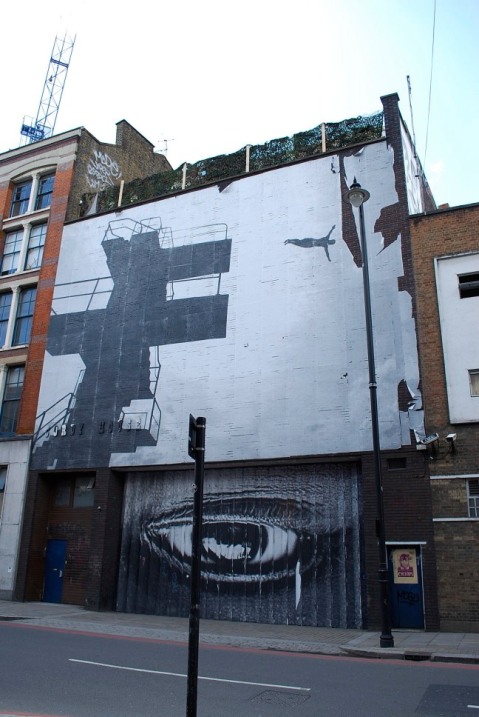
What you can see is an image that is several storeys tall, situated on a building in Old Street in Shoreditch. The massive buildings next to it become simply part of the artwork’s frame. There’s also something of the trompe l’oeuil about the image: it’s black and white, it’s clearly not real, its perspective is all wrong for it to work as a straightforward in situ illusion, but there is something about the image – deriving from its nature as a photograph – which means that the spectator looks into it as well as at it. It is as though two separate worlds have been made to rub up against each other.
While in London in October, I saw JR’s show called 28 Millimetres: Women (it’s just a small part of his massive 28 Millimetres project much of which focuses on post-conflict societies in Africa, more details on JR’s website, and on this aspect of the project see this link).
JR took photographs of some of the inhabitants of Morro da Providencia, a favela in Rio de Janeiro. As is his usual practice, he blew up the photographs and turned them into massive posters which he pasted onto the sides of walls and buildings in the favela. He also used some of these to make some more conventional ‘fine’ artworks, and others were blown up to the enormous sized images which covered some buildings in the street outside. In addition, he made a film in the favela, which features the artworks he made for the buildings but which is also very much an artwork in its own right.
The show took place in the two Lazarides galleries (one in Greek Street, and the other on Charing Cross Road, both in Soho), and on Manette Street, a small street which runs between the two galleries (here’s a link to the Lazarides website and its information about the show). The Greek Street gallery contained the works which most conformed to the genre of the ‘fine’ artwork – that is, individual works, hung on the gallery walls.
These works were mainly photographs, sometimes small, sometimes blown up to considerable size (though nothing that could rival the building-sized images outside). Some work were pasted onto wooden panels, or sheets of rough wood, so that the face or figure in the image enters into a kind of relationship with the texture of the wooden surface, which in some works is fairly smooth but in others is very rough-hewn. The paper covering the wood is often scratched, as if it has been scored with a knife or sharp nails, and thus although the wooden backing and framing of the images seems to give them a sense of place, even though they have been detached from their original home, the images also seem to register an injury…
In Manette Street, some of JR’s massive artworks had been pasted onto the buildings:
In the Charing Cross Road gallery, the walls and ceiling of the exhibition space were covered with printed ‘contact sheets’ of JR’s portrait subjects, replicated over and over in a manner that mimicked the continuous run of celluloid film, as you can see in this photograph:

And on a screen at the rear of the Charing Cross Road gallery, showing on a continuous loop was a short film – for me, the most extraordinary work within this incredible, multi-layered show.
As I’ve mentioned, the film focuses on Morro da Providencia, a favela built on a steep hillside in Rio de Janeiro. As with the multiple levels in the exhibition as a whole, the film combines several elements: music (which is electronic, both urgent and plaintive), some archival news sources, the inclusion of voices speaking over the images (since they speak in Portuguese, the film is sub-titled in English), and a range of cinematographic techniques, including hand-held camera and time-lapse film. (I can’t say exactly how long it lasts – I watched this film several times over, on different days, and, although I tried to time its duration, each time I watched it I became so caught up in its narrative and its affect that I forgot to check my watch at its conclusion.)
The opening shows a news anchor relating a story about the shooting of some of the favela’s inhabitants, after the military opened fire on a public square. And this straightaway establishes the context for the film: the impact of militarised violence and torture inflicted upon a community. After this, the film shows, through time-lapse film, the installation of JR’s images throughout the favela, as they are pasted up on walls and outside houses. For this sequence, the camera is positioned quite a distance away and well below the favela, so that its entire upward sprawl can be seen, with the eyes, mouths, foreheads and faces of JR’s subjects now covering many of the vertical surfaces (there’s a still showing this on the Lazarides website).
But the film’s purpose is not (or not only) to record the installation of these works. JR’s objective is always portraiture, but here he produces a portrait which is multi-faceted enough to do justice both to the many individuals who face the video camera for JR and to the identity and space of the favela itself as a community dealing with the aftermath of police violence.
After the opening, the film is mainly composed of a series of sequences in which the camera races down alley ways and eventually halts in front of an individual – sometimes a woman, often a child, occasionally a man – or in which the camera follows someone through the interconnected rooms of their home, often ending up with that individual (child, woman or man) standing on the flat roof of their home with the favela rising and falling around them.
But although I say the camera ‘halts, or someone ‘ends up’, these words aren’t an accurate description of what the camera is doing, because they imply that some kind of even momentary stasis is reached. Instead, the camera is in constant motion, its film speeded up so that it fairly tears through the streets and alleys. Even when it is apparently at rest and in contemplation of an individual face, it is still recording at an accelerated speed, so that every single blink, glance or expression registers as a twitchy jitter in the subject’s face. In this way, what could have been a languid, leisurely excursus through the favela is rendered urgent, compelling (and fitting the film’s attempt to show how trauma registers within the everyday life of the community and its inhabitants).
And while the camera is building these jittery portraits of place and face, various voices speak (with sub-titled translations). At one point, a woman relates the experience of having to go to the garbage tip to search for pieces of her son’s body, after he had been taken away by soldiers and then killed. Her voice says: ‘it hurts your soul’. Another says: ‘I only give this interview because you are not from here and will take it far away, otherwise I wouldn’t, for I am afraid of the violence’. One boy narrates his witnessing the shooting of three children when the police started firing upon a demonstration in the public square. And another woman speaks of how Providencia had been neglected by artists, and how important JR’s intervention is for the community. She calls it ‘the power of vision’.
Many of the faces which constitute as the film’s jittery portraits are solemn, sombre or impassive. Occasionally a smiling face is shown – a young woman breastfeeding her baby, a little girl laughing. Many of the voices speak of how much they love Providencia, of how grateful they feel to have lived there. Such love, such gratitude, in the context of lives lived amid violence and loss, is amazing. The film completely succeeds in conveying the tension between a sense of the beautiful (the favela as a space of community and happiness) and the experience of violence (the faces whose camera-accelerated jitters seem to bespeak the pain they have undoubtedly suffered, and the favela as a site of loss).
And as such it is a text profoundly about trauma, about the inability to resolve such a contradiction. It is about witnessing violence, and about making art visible. It is about seeing the effects of violence, and about creating an artwork whose faces and eyes look outwards from the hillside towards the city whose police force has inflicted such harm. Through art, the houses are literally made to look, as walls and windows become eyes, faces, bodies. The film ends as night falls over Rio de Janeiro, and these faces, bodies and eyes fade into black, with the camera juddering the distant lights of Rio into a neon blur. Freeze frame, and then black. The film ends, but there is no ‘end’ to what we have seen.
 Leave a comment
Leave a comment